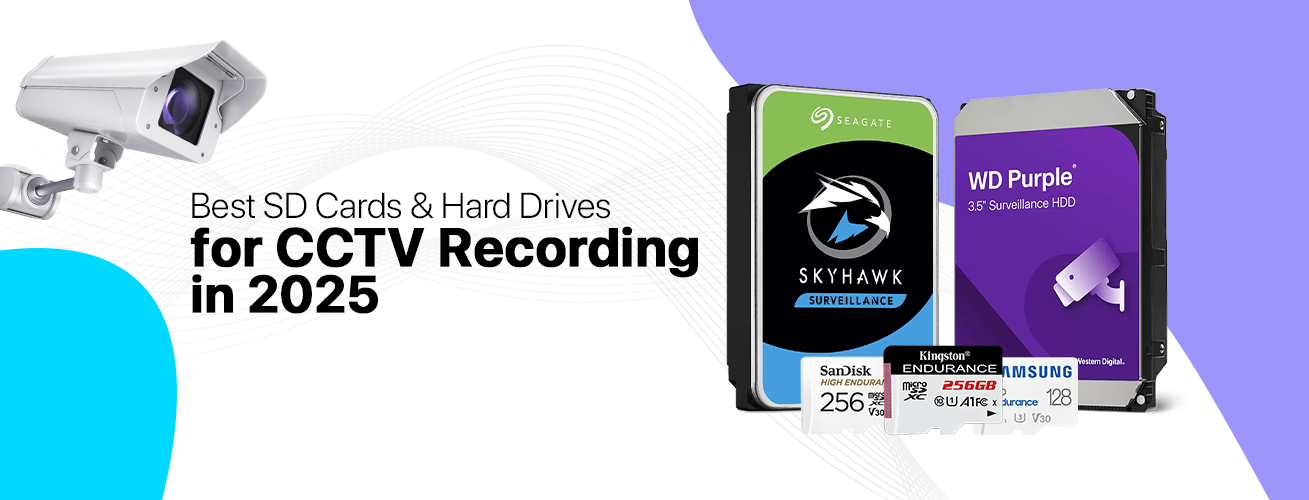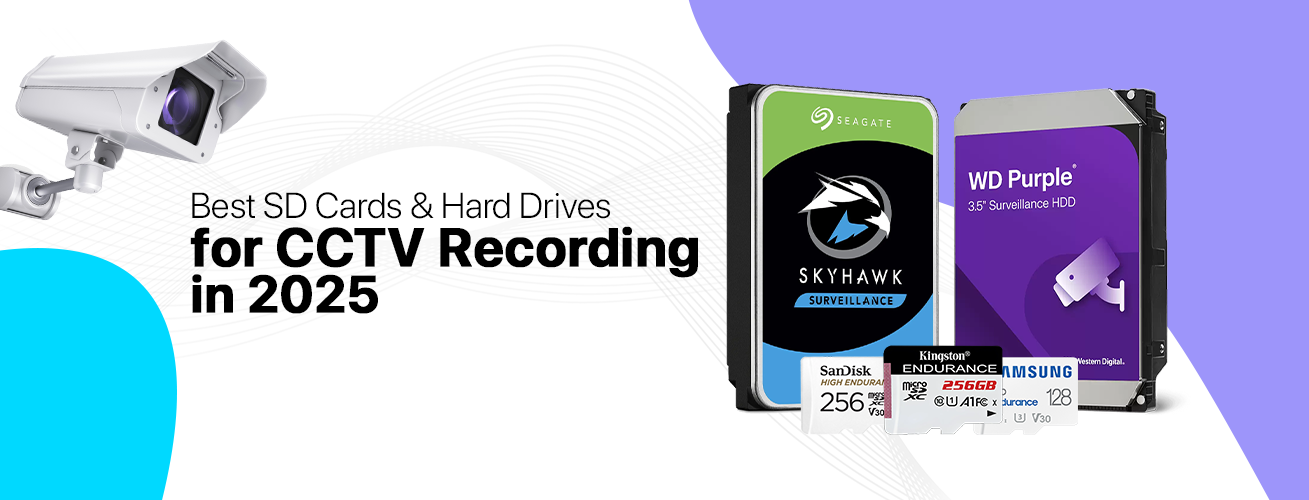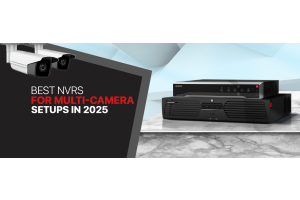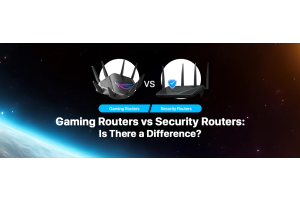

There is no denying that storage has a critical role to play in any surveillance system, whether small-scale or enterprise-grade; it allows you to make sure that recorded footage remains secure, safely retained, and easily accessible. Succinctly speaking, storage solutions should be given utmost priority because, first, they allow secure retention and protection of video recordings; second, reliable storage enables you to handle continuous, heavy data write/read operations efficiently; third, it helps you secure your data by providing reliable backup in case of hardware failure.
Therefore, selecting a specialized and high-resolution storage tailored to your particular surveillance needs is critically important. Having said that, users often find it difficult to choose between an SD card and a hard drive to meet their storage needs. Understanding the pros and cons of both Hard Drives and SD Cards is key to making the right decision. In this comprehensive write-up, we will help you know how to choose the perfect storage and which storage best serves your needs. We will also share our top picks that you should consider in 2025 for the continuous operation and protection of your CCTV recording.
First, we discuss the differences between SD cards and hard drives.
SD Cards vs Hard Drives: A Quick Overview:
SD Card Storage
SD cards are the least costly local storage option that you can choose. They store data on a small chip that is housed inside a plastic casing. These cards are portable, allow uninterrupted recording even during network outages, and they also reduce network traffic.
The size of a typical SD card can range from 32GB to 512 GB. However, it should be noted that the resolution of the camera can influence the duration of storage. For instance, a full HD 2MP camera with H.265 compression can utilize 15GB a day. Obviously, for higher resolution like 4K, you need at least 256GB or 512GB SD cards to avoid frequent overwriting.
Downsides of SD cards are also there. First, they offer limited storage space; second, they can potentially fail or become corrupted, causing permanent loss of data.
For important SD cards that you should look into are as follows:
-
Kingston High Endurance microSD
-
SanDisk High Endurance microSD
Hard Drive Storage:
Hard Disk Drive (HDD) or Solid-State Drives or SSDs can also be used for CCTV local storage for video surveillance. Hard Drives are more reliable than SD cards, and they offer more space as well. Hard Drives are either built within the CCTV camera or they are made part of a Digital Video Recorder (DVR) or a Network Video Recorder (NVR).
SSD drives are often preferred to HDDs because they offer faster speed, better durability, silent operations, enhanced power efficiency, less boot time, less than 0.1 ms data access time, minimum heat generation, longer lifespan, and more.
However, the flip side of these hard drives is also there. Installation of hard drives requires specialized expertise and accessories. They are also prone to damage and data loss.
Here is a table showing differences between SD cards and Hard Drives for quick comparison.
|
Features |
SD Cards |
Hard Drives |
|
Physical Size |
small |
Large, requiring space in laptops or desktops |
|
Storage Capacity |
Limited |
Higher, so much as TB storage is commonly available |
|
Cost-Efficiency |
Cheaper |
Expensive, especially SSD storage |
|
Installation |
Simple, plug-and-play |
Complex, needs a specialized person for installation, requiring NVR/DVR setup as well. |
|
Durability |
Lower, you need continuous overwriting |
Suitable for 24/7 surveillance and security |
|
Network dependence |
Fully independent and operational offline |
Partly independent |
|
Heat & power |
Minimal heat, low power consumption |
Higher heat output and power consumption |
|
Recording duration |
Hours at max |
Longer suitable for days-long recording |
|
Access speed |
Fast |
Usually fast; however, it depends on the network |
|
Use case |
Remote sites, single cameras, portable CCTV setup |
Multi-camera systems |
Now that you have understood fully the salient differences and suitability of SD cards and Hard Drives. But how can you choose a particular storage for your CCTV surveillance system? Let’s discuss key factors to consider to choosing the best-suited storage solution.
Key Factors to Consider in Storage SD Cards and Hard Drives in 2025 & Beyond:
Here are some factors that you need to look into in a CCTV storage, whether SD cards or a Hard Drive.
-
Recording Resolution and Bitrate:
Needless to say, higher resolution, such as 4K, and frame rate of CCTV cameras demand high resolution, requiring more storage. Similarly, a higher bitrate also leads to enhanced storage requirements.
For instance, if you have two cameras with a maximum of 1024 Kbps and they record footage continuously for 7 days. The required storage can be calculated by this formula:
Required storage space = 1024 * 1000/8 * 3600 * 24 * 2 * 7/1000 000 000 = 154.8288 GB
Normally, this formula applies consistently across all brands, including AXIS, Honeywell, Panasonic, Hikvision, and the like. However, you need to consider other factors as well to determine precisely how much storage your CCTV system needs.
-
Endurance and Lifespan:
Endurance and lifespan are other major considerations that you should look into. Normally, hard drives have 3 to 8 years. The endurance and lifespan of Hard Drives (SSDs and HDDs) are measured by two metrics:
-
TBW or Terabyte Written
-
DWPD or Drive Writes Per Day
TBW refers to the total amount of data that can be written to hard drives during their entire lifespan. It is normally considered for SSD drives. For instance, an SSD drive with 600TBW shows that you can write up to 600TB of data to it.
DWPD, as the name indicates, shows the amount of data that you can overwrite the entire capacity of a storage device per day over its warranty period without failure. For instance, for 1 DWPD, you can write data equivalent to the entire capacity of the drive every day.
Both TBW and DWPD are closely interrelated. They are connected by this formula:
DWPD = TBW × 1000 / Warranty days × Capacity in GB
However, there are multiple factors that influence the endurance and lifespan of any CCTV storage.
-
If your CCTV infrastructure is well-maintained, your storage can last up to 8 years, or even longer than that, depending on operating conditions.
-
A hard drive that has been installed for 24/7 surveillance and recording can last up to 5 years; however, if you undertake measures such as environmental control or strategic recording schedules, you can extend its lifespan and endurance to a greater extent.
-
You should also perform regular firmware updates to improve system stability, fix bugs, and enhance performance. These regular firmware updates can contribute directly to the longer endurance and lifespan of your storage hardware, whether SD cards or SSDs, or HDDs.
How much TBW and PWPD do you need for CCTV recording? Here is a table giving you a rough idea.
|
Factors |
Storage Requirement |
Estimated TBW Range |
Estimated DWPD Range |
|
Number of Cameras |
1-32 cameras |
10 TB to 100+ TB |
0.5 – 3 DWPD |
|
Resolution & Frame Rate |
HD (1080p) to 5MP and above |
10–50+ TB |
0.5 – 5 DWPD |
|
Retention Period |
7 days to 90 days |
10 TB to 100 TB+ |
DWPD increases with retention length |
|
Compression Type |
H.264 vs. H.265 |
H.265 can reduce TBW by 50% compared to H.264 |
Lower DWPD is needed with efficient compression. |
|
Storage Capacity per Camera |
20GB/day per 2MP camera or above |
6GB to 6TB per camera total |
Dependent on total writes and system uptime |
-
Environmental Resistance:
Environmental resistance is another key spec that you need to know before making a final decision. Here are some factors that you should consider.
-
Humidity Tolerance:
The storage device must operate smoothly in humid conditions with humidity reaching up to 95%. This level of humidity tolerance can help your storage hardware resist moisture-related damage.
-
Operating Temperature Range:
The HDD or SSD installed for CCTV recording must operate within a temperature range of -20°C to 60°C or even -30°C to 65°C. This ability to work in a wide temperature range can help your devices handle harsh outdoor conditions.
Having discussed the factors you need to know before making an ultimate decision, we now share our top picks when it comes to the best SD cards and Hard drives that you can purchase in 2025.
Best SD Cards for Security Cameras in 2025:
Here are our top picks.
-
SanDisk Extreme V30 UHS-I (128 GB):
This 128GB SanDisk SD card is ranked as the best option for less demanding IP cameras. Featuring faster read and write speeds at the most affordable price, you can find this SD card suitable for your day-to-day CCTV recording needs.
-
Kingston 128GB microSDXC Canvas Go Plus:
With sizes available from 32GB to 512GB and 101 MBps maximum measured speed, this 128GB Kingston microSD Canvas Go Plus Card for IP camera can help you handle 4K video and RAW images. Moreover, the read/write speed is fast enough to capture high-quality imagery. It is equally brilliant SD card solution for both large as well as small files.
Hard Drives for CCTV Cameras:
Hard drives come in various types depending on storage technology and end uses. For instance, Solid-State Drive (SSDs), standard desktop HDD, enterprise HDD, hybrid drives, Network Attached Storage (NAS), and surveillance HDD.
However, given the constraints of our topic, we will discuss the Surveillance Hard Drive only.
What is Surveillance HDD?
As the name indicates, surveillance HDDs are designed specifically for meeting the needs of CCTV surveillance systems. They can support continuous, high-intensity video recording and playback in security camera systems. Unlike desktop HDDs, which need to read/write occasionally, surveillance hard drives are engineered to read/write 24/7 with minimum downtime.
Here are the salient features of surveillance hard disk drives.
-
They can handle considerably higher workload. They come with a typical rating for workloads of 180TB per year or more, unlike a 55TB per year rating of a desktop HDD.
-
Surveillance hard drives support enhanced sequential write speeds, making them suitable for handling multiple high-resolution video streams.
-
They can handle multiple security cameras at a time. Typically, a surveillance HDD can support up to 32 IP or CCTV cameras simultaneously.
-
They feature specialized firmware, such as Western Digital’s AllFrame and Seagate’s ImagePerfect technology, making them suitable for reducing frame loss, improving video clarity, and preventing data corruption.
Top Surveillance Hard Drive for CCTV Recording in 2025:
Selecting the right Surveillance hard drive can make all the difference because it brings durability, system stability, and long-term video recording.
Here are our top picks when it comes to the best surveillance HDD in the USA market.
WD Purple:
Supporting 1TB to 22TB storage, up to 64 cameras, AllFrame firmware, and more, WD Purple is ranked as the best Surveillance hard drive suitable for low power use, RAID setup, and wide compatibility with various CCTV cameras.
Seagate SkyHawk:
Featuring up to 24TB storage, 62-128 CCTV cameras support, ImagePerfect firmware, Seagate SkyHawk is recommended for large security systems and enterprise-grade AI surveillance setups in the USA.
Toshiba S300:
Toshiba S300 comes with up to 6TB storage, support for up to 32 cameras, and Standard Firmware. It is suggested for budget-friendly surveillance systems suitable for small homes and offices.
Final Words:
The selection of a reliable and suitable storage for CCTV recording is crucial. Regarding this, you need to decide between SD cards and hard drives. As far as hard drives, particularly surveillance HDDs, are concerned, you need to make a well-informed decision. Concerning this, if you are looking for smart or AI-empowered surveillance, you must go for SkyHawk AI or WD Purple Pro.
If you are searching for budget-friendly surveillance storage for home/office uses, Toshiba S300 or MaxDigitalData would be enough for your needs. Finally, you need to make sure that the firmware is compatible with your NVR or DVR brand, and the drive must come with support for RAID and environmental protection.







